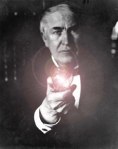There is an entrepreneur in almost every government employee. It just needs to be unleashed.
“Innovation” is an overused word, especially in government. Chief Innovation Officers are sprouting up in state and local governments as fast as dandelions bloom in the springtime.
I’ve contributed to this trend myself, publicly advocating Seattle’s new Mayor Ed Murray to appoint a Chief Innovation Officer. He did appoint Robert Feldstein as Chief of Policy and Innovation (although my advocacy probably had little to do with that).
But can government employees at any level – City, County, State or Federal – really innovate? Or are they doomed to be unrepentant bureaucrats, steadily but blindly following rules and procedures?
What is “innovation”?
I like Bryan Sivak’s definition of innovation as the “freedom to experiment”.
Many organizations – not just government, but really any large organization (think Boeing, the cable company, Microsoft) is captive to its rules, regulations, processes and procedures – its “bureaucracy”. Governments are especially captive to their processes because they are subject to public scrutiny and criticism. Many government officials hide behind policies and procedures saying “we treat everyone uniformly and equally” even though uniform processes often produce discriminatory results due to the differing circumstances of neighborhoods and individuals.
Consider a police department, for example, which handled abandoned cars in a uniform way. Callers were directed to a voicemail where they left information about the abandoned car in their neighborhood. The information was transcribed onto slips of paper which were then given to parking enforcement officers (PEO) for each neighborhood who, along with a host of other duties, would track the cars down and tag them – when the PEO had time. This business process had numerous problems – on weekends the voicemail box would become filled, and callers became frustrated. Slips of paper became lost, or the information was improperly transcribed. In some neighborhoods PEOs were overworked with other issues, and didn’t get to tagging the abandoned cars.
Freedom to experiment takes a lot of guts on the part of government officials. By giving their employees or teams the freedom to try new processes – new ways of handling old problems – they must understand experiments may fail, subjecting their department to criticism. “Fail fast, fail cheap, learn from the failure.”
Innovation is not just about Technology
In this razzle-dazzle world of the 21st century, we tend to think of “innovation” as synonymous with some cool new smartphone app or a new computer system which automates a paper-based process.
But the best innovations don’t necessarily involve technology. Indeed, they often are just changes in business process, sometimes enhanced by technology.
For example, consider Seattle’s antiquated process for approval of siting of cabinets in the roadways. These cabinets contain telecommunications equipment which allow higher speed internet in neighborhood. Placing the cabinets allows private companies to build high-speed fiber networks deep into the city. But, sometime in 2008 or 2009, someone complained to a deputy Mayor that one of the cabinets appeared in a neighborhood and was unsightly and intrusive. The City’s response was to create a draconian rule forcing telecom companies to get explicit approval of all homeowners, within 100 feet of a proposed cabinet, throughout the entire City of Seattle.
Such a rule has many problems, not the least of which is stifling competition to provide high speed internet. But the City’s proposed response is to lift the rule, but require telecom companies to pay an annual fee for each cabinet. The fee is, supposedly, to pay inspectors to make sure the cabinets don’t become overgrown by weeks or marked by graffiti. In an age of 311 and citizen activism, with cameras in every smart phone, this is a solution worthy of the 1930s! Clearly the city employees involved here are still living in a risk-adverse, anti-innovation age.
We do NOT want governments innovating on some issues.
Washington State just suffered a devastating mudslide near the town of Oso on State Highway 530. Forty-three residents of that neighborhood lost their lives. In some places in Washington State – and elsewhere – building codes would have restricted the construction of a home in a slide-prone area. At the very least, the potential homebuilders could have been forced to acknowledge the danger in the area before they constructed. Yet a few homeowners in Oso actively resisted such “government intrusion”.
We also want to be careful in how we innovate in matters involving public safety. We don’t want experimentation with different shapes or colors of stop signs, for example. In areas subject to hurricanes, earthquakes and similar natural disasters we probably want to be careful in how we change building codes.
“Government Entrepreneur” is Not an Oxymoron
Mitchell Weiss said it best when he wrote this article in the Harvard Business Review on March 28th. “The idea of ‘public entrepreneurship’ may sound … like it belongs on a list of oxymorons … But it doesn’t. Public entrepreneurs around the world are improving our lives, inventing entirely new ways to serve the public.” He cited a list of entrepreneurship in government, and there are many additional examples ranging from open data which begets a host of private sector apps to 311 to New Urban Mechanics, which has “institutionalized innovation” (and perhaps that IS an oxymoron) by both government employees and citizens.
Some things are best left to the private sector.
How about healthcare.gov as the poster child for this one? No matter what you think of the Affordable Healthcare Act, the online implementation sucked. Kurt del Bene, formerly of Microsoft, led a turn-around, but President Obama deserves credit for giving him the authority to fix the site. And damn the bureaucrats in the Center for Medicaid Services (CMS) who used “tried and true” (i.e. non-innovative) processes to create it and failed badly. Indeed, some states did much better, e.g. Washington. In each case, however, engaging private sector companies and individuals is key to success.
Innovation is really about Leadership
It takes a lot of guts to be an innovative Mayor or Governor. You’ll be subject to critics from every angle. Government employees don’t want change because “this is the way we’ve always done it” and they fear individual responsibility to make decisions. Members of the public and business communities will immediately line up on one side or the other, perceiving themselves as winners or losers.
Yet examples of courageous, innovating, leaders are abundant. In 1944, Franklin Roosevelt forced the Washington Correspondents Association to admit an African-American reporter Harry McAlpin. In 1964 Lyndon Johnson pushed civil rights legislation despite the obvious and continuing (to this day) damage to the Democratic Party in the South. Just this year, Mayor Ed Murray of Seattle pushed a $15 minimum wage and obtained a supermajority of 21 of 24 members of his business-labor committee on a plan.
Great leaders know when to push, when to ask, when to cajole, and, most important, how to accept risk to push forward innovation and improvement in government.
There is an entrepreneur in (almost) every government employee and every citizen. It just needs to be unleashed.






